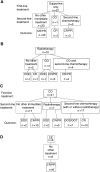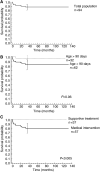Treatment of stage 4s neuroblastoma--report of 10 years' experience of the French Society of Paediatric Oncology (SFOP)
- PMID: 12888814
- PMCID: PMC2394373
- DOI: 10.1038/sj.bjc.6601154
Treatment of stage 4s neuroblastoma--report of 10 years' experience of the French Society of Paediatric Oncology (SFOP)
Abstract
Stage 4s neuroblastoma (NB) is usually associated with a favourable outcome, despite a large tumour burden, as spontaneous regression frequently occurs. However, in some infants rapid disease progression can be observed with severe functional impairment. Thus, for all patients the potential risks of cytotoxic therapy must be weighed against the benefits of early medical intervention. We have retrospectively reviewed the charts of 94 infants treated for stage 4s NB in centres of the French Society of Paediatric Oncology between 1990 and 2000, and describe the different first-line treatment approaches that were, successively, liver irradiation, chemotherapy using a cyclophosphamide-vincristine regimen, and chemotherapy using a carboplatin-etoposide regimen. The overall survival was 88% (+/-7.6%), with a mean follow-up of 64 months. Elevated serum neuron-specific enolase (>100 nmol ml(-1)), ferritin (>280 ng ml(-1)) and urinary dopamine levels (>2500 nmol mmol(-1) creatinine) were associated with a poor outcome, as were the genetic markers N-myc amplification and chromosome 1p deletion (P<0.0005 and P=0.0016, respectively). Patients who required medical intervention at diagnosis fared worse than those who received supportive treatment only (P<0.005). The clinical evolution observed with the different successive treatment approaches suggests that if infants do require therapy, the prompt initiation of a more intensive regimen such as carboplatin-etoposide may be more beneficial.
Figures


Similar articles
-
N-Myc gene amplification is a major prognostic factor in localized neuroblastoma: results of the French NBL 90 study. Neuroblastoma Study Group of the Société Francaise d'Oncologie Pédiatrique.J Clin Oncol. 1997 Mar;15(3):1171-82. doi: 10.1200/JCO.1997.15.3.1171. J Clin Oncol. 1997. PMID: 9060561
-
Unresectable localized neuroblastoma: improved survival after primary chemotherapy including carboplatin-etoposide. Neuroblastoma Study Group of the Société Française d'Oncologie Pédiatrique (SFOP).Br J Cancer. 1998 Jun;77(12):2310-7. doi: 10.1038/bjc.1998.384. Br J Cancer. 1998. PMID: 9649151 Free PMC article. Clinical Trial.
-
Stage 4S neuroblastoma, a disseminated tumor with excellent outcome.Saudi Med J. 2006 Nov;27(11):1734-6. Saudi Med J. 2006. PMID: 17106552
-
Favorable histology, MYCN-amplified 4S neonatal neuroblastoma.Pediatr Blood Cancer. 2007 Apr;48(4):479-82. doi: 10.1002/pbc.20705. Pediatr Blood Cancer. 2007. PMID: 16333837 Review.
-
Ifosfamide, carboplatin, and etoposide for neuroblastoma: a high-dose salvage regimen and review of the literature.Cancer. 2013 Feb 1;119(3):665-71. doi: 10.1002/cncr.27783. Epub 2012 Sep 5. Cancer. 2013. PMID: 22951749 Review.
Cited by
-
International Society of Paediatric Surgical Oncology (IPSO) Surgical Practice Guidelines.Ecancermedicalscience. 2022 Feb 17;16:1356. doi: 10.3332/ecancer.2022.1356. eCollection 2022. Ecancermedicalscience. 2022. PMID: 35510137 Free PMC article.
-
Pirarubicin Combination Low-Dose Chemotherapy for Early Infantile Stage MS Neuroblastoma: Case Report.Children (Basel). 2023 May 12;10(5):871. doi: 10.3390/children10050871. Children (Basel). 2023. PMID: 37238419 Free PMC article.
-
Neuromedin U and neurotensin may promote the development of the tumour microenvironment in neuroblastoma.PeerJ. 2021 Jun 1;9:e11512. doi: 10.7717/peerj.11512. eCollection 2021. PeerJ. 2021. PMID: 34141479 Free PMC article.
-
The Skin as an Early Expression of Malignancies in the Neonatal Age: A Review of the Literature and a Case Series.Biomed Res Int. 2015;2015:809406. doi: 10.1155/2015/809406. Epub 2015 Dec 21. Biomed Res Int. 2015. PMID: 26798643 Free PMC article. Review.
-
Diagnosis of neonatal neuroblastoma with postmortem magnetic resonance imaging.Radiol Case Rep. 2016 Dec 7;12(1):191-195. doi: 10.1016/j.radcr.2016.08.019. eCollection 2017 Mar. Radiol Case Rep. 2016. PMID: 28228908 Free PMC article.
References
-
- Bown N, Cotterill S, Lastowska M, O'Neill S, Ellershaw C, Roberts P, Lewis I, Pearson AD, UK Cancer Cytogenetics Group and the UK Children's Cancer Study Group (1999) Gain of chromosome arm 17q and adverse outcome in patients with neuroblastoma. N Engl J Med 340: 1954–1961 - PubMed
-
- Brodeur GM, Seeger RC, Barrett A, Berthold F, Castleberry RP, D'Angio G, De Bernardi B, Evans AE, Favrot M, Freeman AI (1988) International criteria for diagnosis, staging, and response to treatment in patients with neuroblastoma. J Clin Oncol 6: 1874–1881 - PubMed
-
- Brodeur GM, Pritchard J, Berthold F, Carlsen NL, Castel V, Castelberry RP, De Bernardi B, Evans AE, Favrot M, Hedborg F, Kaneko M, Kemshead J, Lampert F, Lee REJ, Look T, Pearson ADJ, Philip T, Roald B, Sawada T, Seeger R, Tsuchida Y, Voute PA (1993) Revisions of the international criteria for neuroblastoma diagnosis, staging, and response to treatment. J Clin Oncol 11: 1466–1477 - PubMed
-
- Caron H (1995) Allelic loss of chromosome 1 and additional chromosome 17 material are both unfavorable prognostic markers in neuroblastoma. Med Pediatr Oncol 24: 215–221 - PubMed
-
- De Bernardi B, Pianca C, Boni L, Brisigotti M, Carli M, Bagnulo S, Corciulo P, Mancini A, De Laurentis C, Di Tullio MT, di Montezemolo LC, Lanino E, Clerico A, Rogers DW, Bruzzi P (1992) Disseminated neuroblastoma (stage IV and IV-S) in the first year of life. Outcome related to age and stage. Italian Cooperative Group on Neuroblastoma. Cancer 15: 1625–1633 - PubMed
MeSH terms
Substances
LinkOut - more resources
Full Text Sources
Medical

